

Columbo is a computer forensic analysis tool used to simplify and identify specific patterns in compromised datasets.
Columbo
Columbo is a computer forensic analysis tool used to simplify and identify specific patterns in compromised datasets. It breaks down data to small sections and uses pattern recognition and machine learning models to identify adversaries behaviour and their possible locations in compromised Windows platforms in a form of suggestions. Currently Columbo operates on Windows platform.
Dependencies & High Level Architecture
Columbo depends on volatility 3, autorunsc.exe and sigcheck.exe to extract data. Therefore users must download these dependent tools and place them under \Columbo\bin folder. Please Make sure you Read and Understand the license section (or License.txt file) before you download anything. The output (data) generated by these tools are automatically piped to Columbo’s main engine. It breaks it down to small sections, pre-process it and applies machine learning models to classify the location of the compromised system, executable files and other behaviours.
Get started with Columbo
Demo
Before you start Columbo
Memory forensics using Columbo
Installation and Configuration
Executable -Binary
- Download and install python 3.7 or 3.8 (not tested with 3.9). Make sure you add python.exe to the PATH during the installation.
- Download latest binary Columbo release, under Releases
- Download each of the following and place them under \Columbo\bin.
- Volatility 3 source code. Columbo does not support Volatility 2. Please make sure you also download Symbol table packs for windows, unzip it and put it under \Columbo\bin\volatility3-master\volatility\symbols.
- Download both autorunsc.exe and sigcheck.exe
NB: To avoid errors, The directory structure must be like \Columbo\bin\volatility3-master , \Columbo\bin\autorunsc.exe and \Columbo\bin\sigcheck.exe
Finally double click on “main.exe” under \Columbo.
Source Code
- Download and install python 3.7 or 3.8 (not tested with 3.9). Make sure you add python.exe to the PATH during the installation.
- Download the latest release version of Columbo – source code.
- Double click on install-prerequisites.bat to install all the required packages.
- Download each of the following and place them unde \Columbo\bin.
- Volatility 3 source code. Columbo does not support Volatility 2. Please make sure you also download Symbol table packs for windows, unzip it and put it under \Columbo\bin\volatility3-master\volatility\symbols
- Download both autorunsc.exe and sigcheck.exe.
NB: To avoid errors, The directory structure must be like this \Columbo\bin\volatility3-master , \Columbo\bin\autorunsc.exe and \Columbo\bin\sigcheck.exe
Finally go to cmd and issue python.exe \Columbo\main.py
Columbo and Machine Learning
Columbo uses data preprocessing to organise the data and machine learning models to identify suspicious behaviours. Its outputs are either 1 (suspicious) or 0 (genuine) -in a form of suggestions purely to assist digital forensic examiners in their decision making. We have trained the models with different examples to maximise accuracy and used different approaches to minimise false positives. However, false positives (false detection) are still experienced and therefore we are committed to update the models periodically.
False Positive
It’s not easy to reduce false positives (false detection), especially when we deal with machine learning. The output generated by machine learning models might be false positive depending on the quality of the data used to train the models. However, to assist forensic examiners in their investigation, Columbo generates percentage scores for each 1 (suspicious) and 0 (genuine). Such approach helps the examiners to pick and choose the path, command or processes that Columbo classifies them as suspicious.
Options to Select
Option 2
Live analysis -files and process traceability. This option analyses running Windows processes to identify running malicious activities if any. Columbo uses autorunsc.exe to extract the data from the machine, the outputs are piped to Machine Learning models and pattern recognition engines to classify suspicious activities. Later the outputs are saved under \Columbo\ML\Step-2-results in a form of excel files for further analysis. Furthermore, users are given options to examine running processes. The result contains information such as process traceability, commands that are associated with each process -if applicable and whether or not, the processes are responsible for executing new processes.
Option 3
Scan and analyse Hard Disk Image File (.vhdx): This option takes paths of mounted Hard Disk Image of Windows. It uses sigcheck.exe to extract the data from the file systems. Then the results are piped into Machine Learning models to classify suspicious activities. Further the outputs are saved under \Columbo\ML\Step-3-results in a form of excel files.
Option 4
Memory Forensics. In this option, Columbo takes the path of the memory image and following options are produced for users to select.
- Memory Information: Volatility 3 is used to extract information about the image.
- Processes Scan: Volatility 3 is used to extract process, dll and handle information of each process. Then, Columbo uses grouping and clustering mechanisms to group each process according to their mother processes. This option is later used by the process traceability under Anomaly Detection option.
- process Tree: Volatility 3 is used to extract process tree of the processes.
- Anomaly Detection and Process Traceability: Volatility 3 is used to extract a list of Anomaly Detection processes. However, Columbo gives an option called Process Traceability to separately examine each process and collectively produces the following information.
- Paths of the executable files and associated commands.
- Using Machine Learning models to determine the legitimacy of the identified processes.
- Trace each process all the way back to their root processes (complete path) and their execution dates and time.
- Identify if the process is responsible for executing other processes i.e. is it going to be a mother process of new processes or not.
- It extracts, handles and dlls information of each process and presents them with the rest of the information.
License
MIT License
Columbo
Copyright 2020 Visma
Permission is hereby granted, free of charge, to any person obtaining a copy of this software and associated documentation files (the “Software”), to deal in the Software without restriction, including without limitation the rights to use, copy, modify, merge, publish, distribute, sublicense, and/or sell copies of the Software, and to permit persons to whom the Software is furnished to do so, subject to the following conditions:
The above copyright notice and this permission notice shall be included in all copies or substantial portions of the Software.
THE SOFTWARE IS PROVIDED “AS IS”, WITHOUT WARRANTY OF ANY KIND, EXPRESS OR IMPLIED, INCLUDING BUT NOT LIMITED TO THE WARRANTIES OF MERCHANTABILITY, FITNESS FOR A PARTICULAR PURPOSE AND NONINFRINGEMENT. IN NO EVENT SHALL THE AUTHORS OR COPYRIGHT HOLDERS BE LIABLE FOR ANY CLAIM, DAMAGES OR OTHER LIABILITY, WHETHER IN AN ACTION OF CONTRACT, TORT OR OTHERWISE, ARISING FROM, OUT OF OR IN CONNECTION WITH THE SOFTWARE OR THE USE OR OTHER DEALINGS IN THE SOFTWARE.
Third party tools
- It’s users responsibility and not Columbo’s to download and use third party tools required by Columbo.
- It’s also the user’s responsibility and not Columbo’s to agree or disagree on the license agreement provided by the third party tools.
- In relation to MS SysInternal tools. Columbo passes option/argument -accepteula on the command lines in order to operate non-interactively. It’s also the user’s responsibility and not Columbo’s to agree or disagree on the license agreement provided by MS SysInternal tools.




















Leave a Reply